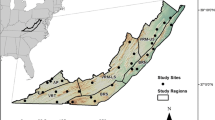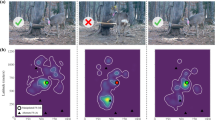Abstract
Movement patterns of white-tailed deer (Odocoileus virginianus) and Spanish goats (Carpa hircus) were mapped and analyzed to test the hypothesis that foraging movements and behaviors within an Acacia shrub community are significantly related to environmental heterogeneity. Animal response to plant community heterogeneity was characterized using foraging velocity and the animals' foraging path fractal dimension (Dd). Environmental heterogeneity was characterized using the perimeter:area fractal dimension, which represents the shape of shrubs, and the grid count fractal dimension, which represents shrub spatial distribution. The foraging paths of deer were straighter and more directed (Dd = 1.27) than those of goats (Dd = 1.53), and deer responded to the shape of shrub patches, more so than to shrub distribution. The tortuosity of goat foraging paths was apparently affected by distribution of blackbrush (Acacia rigidula) and shrubby bluesage (Salvia ballotiflora). Foraging velocity of deer was affected by the distribution and shape complexity of guajillo (A. berlandieri), which was a major dietary component. In contrast, foraging velocity of goats was affected by the shape complexity of the entire shrub community and by the distribution of ceniza (Leucophylum frutescens), a non-dietary, but prevalent component of the plant community. Results indicate that these two browsing herbivores perceive the same landscape differently.
Similar content being viewed by others
References
Addicott J.F., J.M. Aho, M.F. Antolin, D.K. Padilla, J.S. Richardson and D.A. Soluk. 1987. Ecological neighborhoods: scaling environmental patterns. Oikos 49: 340–346.
Bailey, D.W. 1995. Daily selection of feeding areas by cattle in homogeneous and heterogeneous environments. Appl Anim Behav Sci 45: 183–200.
Bell, W.J. 1991. Searching behavior the behavioral ecology of finding resources. Edited by D.M. Broom and P.W. Colgan. Chapman and Hill, NY.
Crist, T.O., D.S. Guertin, J.A. Wiens and B.T. Milne. 1992. Animal movement in heterogeneous landscapes: an experiment with Elodes beetles in shortgrass prairie. Functional Ecology 6: 536–544.
Crist, T.A. and J.A. Wiens. 1994. Scale effects of vegetation on forager movement and seed harvesting by ants. Oikos 69: 37–46.
Dicke, M. and P.A. Burrough. 1988. Foraging in a landscape mosaic: selection for energy and minerals in free-ranging cattle. Oecologia 100: 107–117.
Gillingham, M.P. and F.L. Bunnell. 1989. Black-tailed deer feeding bouts: dynamic events. Can J Zool 67: 1353–1362.
Gross, J.E., C. Zank, N.T. Hobbs and D.E. Spalinger. 1995. Movement rules for herbivores in spatially heterogeneous environments: responses to small scale pattern. Landscape Ecology 10: 209–217.
Hervey, R.L. 1989. Effects of grazing pressure of Angora goats on intra/interspecific foraging competition with white-tailed deer. MS thesis. Texas A&M University, College Station, TX.
Johnson, A.R. and B.T. Milne. 1992. Diffusion in fractal landscapes: Simulations and experimental studies of tenebrionid beetle movements. Ecology 73: 1968–1983.
Koerth, B.H. and J.W. Stuth. 1991. Instantaneous intake rates of 9 browse species by white tailed deer. J Range Manage 44: 614–618.
Kolasa, J. and C.D. Rollo. 1991. Introduction: The heterogeneity of heterogeneity: A glossary. In Ecological Heterogeneity. Edited by J. Kolasa and S.T.A. Pickett. Springer-Verlag, New York.
Kotliar, N.B. and J.A. Wiens. 1990. Multiple scales of patchiness and patch structure: a hierarchical framework for the study of heterogeneity. Oikos 59: 253–260.
Leduc, A. L., Y.T. Prairie and Y. Bergeron. 1994. Fractal dimension estimates of a fragmented landscape: sources of variability. Landscape Ecology 4: 279–286.
McGarigal, K. and B.J. Marks. 1994. FRAGSTATS 2.0: Spatial pattern analysis program for quantifying landscape structure. Oregon State University, Corvallis, OR.
Milne, B.T. 1991. Fractal Models. In Quantitative Methods in Landscape Ecology: The Analysis and Interpretation of Landscape Heterogeneity. Edited by M.G. Turner and R.H. Gardner. Springer-Verlag. New York.
Milne, B.T. 1988. Measuring the fractal geometry of landscapes. Appl Math and Comp 27: 67–79.
Naveh, Z. and A.S. Lieberman. 1994. Landscape Ecology Theory and Application. Second Edition, Springer-Verlag, New York.
O'Neill, R.V., J.R. Krummel, R.H. Gardner, G. Sugihara, B. Jackson, D.L. DeAngelis, B.T. Milne, M.G. Turner, B. Zygmunt, S.W. Christensen, V.H. Dale and R.L. Graham. 1988a. Indices of landscape pattern. Landscape Ecology 1: 153–162.
O'Neill, R.V., B.T. Milne, M.G. Turner and R.H. Gardner. 1988b. Resource utilization scales and landscape pattern. Landscape Ecology 2: 63–69.
Russell, R.W., G.L. Hunt, Jr., K.O. Coyle and R.T. Cooney. 1992. Foraging in a fractal environment: spatial patterns in a marine predator-prey system. Landscape Ecology 7: 195–209.
Senft, R.L., M.B. Coughenour, D.W. Bailey, L.R. Rittenhouse, O.E. Sala and D.M. Swift. 1987. Large herbivore foraging and ecological hierarchies. BioScience 37: 789–799.
Shipley, L.A., D.E. Spalinger, J.E. Gross, N.T. Hobbs and B.A. Wunder. 1996. The dynamics and scaling of foraging velocity and encounter rate in mammalian herbivores. Functional Ecology 10: 234–244.
Sugihara, G. and R.M. May. 1990. Applications of fractals in ecology. Trends in Ecol and Evol 5: 79–86.
Turchin, P. 1991. Translating foraging movements in heterogeneous environments into the spatial distribution of foragers. Ecology 72: 1253–1266.
Ward, D. and D. Saltz. 1994. Foraging at different spatial scales: dorcas gazelles foraging for lilies in the Negev desert. Ecology 75: 48–58.
With, K.A. 1994a. Ontogenetic shifts in how grasshoppers interact with landscape structure: an analysis of movement patterns. Functional Ecology 8: 477–485.
With, K.A. 1994b. Using fractal analysis to assess how species perceive landscape structure. Landscape Ecology 9: 25–36.
Wiens, J.A., T.O. Crist, K.A. With and B.T. Milne. 1995. Fractal patterns of insect movement inmicrolandscape mosaics. Ecology 76: 663–666.
Wiens, J.A. and B.T. Milne. 1989. Scaling of 'landscapes' in landscape ecology, or, landscape ecology from a beetle's perspective. Landscape Ecology 3: 87–96.
Author information
Authors and Affiliations
Rights and permissions
About this article
Cite this article
Etzenhouser, M.J., Owens, M.K., Spalinger, D.E. et al. Foraging behavior of browsing ruminants in a heterogeneous landscape. Landscape Ecology 13, 55–64 (1998). https://doi.org/10.1023/A:1007947405749
Issue Date:
DOI: https://doi.org/10.1023/A:1007947405749




